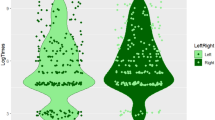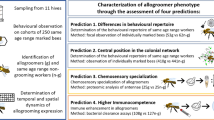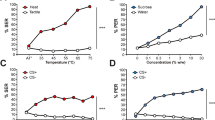Abstract
Sophisticated cognitive abilities have been documented in honeybees, possibly an aspect of their complex sociality. In vertebrates brain asymmetry enhances cognition and directional biases of brain function are a putative adaptation to social behaviour. Here we show that honeybees display a strong lateral preference to use their right antenna in social interactions. Dyads of bees tested using only their right antennae (RA) contacted after shorter latency and were significantly more likely to interact positively (proboscis extension) than were dyads of bees using only their left antennae (LA). The latter were more likely to interact negatively (C-responses) even though they were from the same hive. In dyads from different hives C-responses were higher in RA than LA dyads. Hence, RA controls social behaviour appropriate to context. Therefore, in invertebrates, as well as vertebrates, lateral biases in behaviour appear to be associated with requirements of social life.
Similar content being viewed by others
Introduction
Honeybees, with a brain of only 960,000 neurons, are capable of a surprising degree of higher cognitive function, including the ability to cope with the concept of ‘sameness’1, recognize human faces2, use top-down visual processing3, balance conflicting speed accuracy demands in task allocation4, solve complex maze-type problems and show context-dependent learning5 and to use a symbolic dance system to communicate with conspecifics6. In much larger vertebrate brains regional specialization is used for solving complex tasks7. One example of such regional specialization is the different functioning of the left and right sides of the nervous system (lateralization), which seems to be associated (albeit not in a linear fashion) with enhanced cognition in vertebrates (reviewed in 8). The miniature brains of invertebrates may also rely on lateralization for solving complex tasks. Evidence for lateralization in invertebrates is growing9 but to date evidence for lateralization in honeybees has been provided only for simple olfactory classical conditioning, namely asymmetry in use of the antennae10,11 with associated asymmetry of anatomy (i.e. sensilla number and electroantennographic responses of antennal neurons12,13). Such regional specialization may be very useful in brains with a relatively small number of neurons but this would not require all or most bees to be lateralized in the same direction (i.e. directional bias). However, this is the case: antennal asymmetry with the same direction of bias is apparent in the majority of bees tested (in different laboratories14 and of different species15). In all cases, learning and short-term (<3 h) recall of olfactory memories is performed better with use of the right antenna10,11 and recall of long-term memory is better with use of the left antenna11,15. In vertebrates a link between sociality and directional biases in brain and behaviour has been argued on theoretical grounds16,17 and appears to be well supported by empirical data (e.g. directional biases are apparent in schooling fishes species but not in non-schooling species18). Considering these facts, we wondered whether the rich social life of honeybees may be associated with directional biases in antennal use. Here we report for the first time a strong lateral preference in honeybees to use their right antenna in social interactions with conspecifics.
Results
In bees from the same colony, significant differences were found between LA and RA dyads in latency to contact, number of proboscis extension responses (PER) and number of C-responses (Fig. 1). A PER involves unfolding of the proboscis (tongue) as in feeding and a C-response involves arching the abdomen into a C-shape so that the sting and mandibles are pointed at the other bee. Dyads of bees using their right antennae (RA) took significantly less time to make the first contact with each other than did dyads using their LA (p = 0.036). RA dyads also scored more PER in mutual interaction than did LA dyads (p = 0.030). We had predicted these differences from earlier research showing use of the RA in learning and short-term recall11. In fact the behaviour of RA dyads was the same as that of dyads of intact bees (BA), whereas PER in LA dyads was significantly lower than in BA dyads (p = 0.023), suggesting that the right antenna controls this social behaviour in intact bees. PER scores included sampling the scent/taste of another bee and trophallaxis. Even the latter is primarily for social communication since in more than 95% of interactions it does not involve exchange food19 and is, as for other PER, an aspect of non-agonistic social interaction.
Means and standard errors of each type of behaviour recorded during the testing period, dishes interconnected.
Latency of the bees to make first contact and total number of proboscis extension responses (PERs), C-responses and mandibulations (opening of the mandibles) in the 5-minute test period. Bars marked a differ significantly from those marked b and the same applies to c versus d and e versus f. LA refers to bees with only a left antenna (right antenna removed), RA to bees with only a right antenna and BA intact bees with both antennae. Photograph by E. Rigosi, modified by E. Frasnelli.
Since C-responses (i.e. aggressive interactions) were significantly fewer in RA dyads than in LA dyads (p = 0.006), it seems that the right antenna elevates explorative social interactions and suppresses aggressive social interactions between members of the same colony.
In bees from different colonies, there was no lateralized difference in latency to contact, owing to longer latency in the RA condition compared to latency of RA in same colony dyads (p = 0.046). No lateralization was seen in the PER of dyads from different colonies but clear lateralization was present in C-responses. Unexpectedly, LA dyads of bees from different colonies performed fewer C-responses than RA dyads (p = 0.053): the direction of the asymmetry was the opposite of that in same-colony dyads. From this finding we conclude that the right antenna controls social behaviour appropriate to context. Dyads using their LA do not adjust their agonistic behaviour (C-responses) according to the social context.
C-responses were more common in both BA dyads and RA dyads than in their counterparts in dyads from the same colony, which confirms the interpretation of this behaviour as aggressive. Mandibulation is another aggressive social behaviour, as evidenced by elevation of its occurrence in interactions between bees from different colonies compared to those between bees from the same colony (for comparison of BA dyads, p = 0.026, for RA dyads, p = 0.01 and for LA dyads, p = 0.047; Fig. 1). However, no significant differences were found between LA and RA dyads in interactions between bees from the same or different colonies. Hence, no lateralization was seen for this behaviour.
Discussion
Our results show that at least three most important measures of social interaction, latency to contact, proboscis extension and C-responses, depend on use of the antennae in a lateralized way. The RA is, therefore, not only specialized for learning about new odours associated with food sources but also in exchange of odoriferous information between same-colony worker bees and in control of aggressive responses between different-colony worker bees. It is also use of the RA that motivates bees to approach and contact each other. Although use of the LA does not cause bees to completely avoid each other, social behaviour performed is not context-appropriate, possibly due to an inability to distinguish between hive mates and bees from another hive.
Such surprising observations open the door to investigation of lateralization or side biases in other forms of social behaviour of honeybees, including communication by dancing, which might also benefit from asymmetry of function.
Methods
Bees
Honeybees (Apis mellifera carnica) from two colonies were collected between 09.00 and 10.00 h as they flew out of two hives. They were taken to the laboratory in individual vials (60 mL) and there cooled briefly (at 4°C) until immobile. The left or right antenna was removed using microsurgical scissors (Vannas micro-scissors, 8 cm, 0.5 mm tips, World Precision Instruments Inc.), oriented on the frontal midline so that there was no bias depending on which antenna was cut (Fig. 2). The antenna was cut at the base of the scape or basal stalk. Bees to be tested intact were cooled and handled in the same way.
Then each bee was fed 10–20 ul of 50% sugar solution (w:w), after which it remained in the same vial for 2 hours before testing. The vials we kept in darkness at 250 C and 60% of humidity.
Test
At testing, dyads were formed from the same colony or from different colonies (total of 70 dyads). Testing took place in two petri dishes (9 cm diam × 1.5 cm depth) modified so that each had a small opening (0.7 × 1.3 cm) in the lower and upper lids. These openings could be closed by turning the lid. The two dishes were placed upside-down along side each other and secured so that the openings in the now lower lids were next to each other. The now upper lid had small holes to allow circulation of air. The apparatus was placed inside a white, featureless, circular arena of 31 cm diameter and 35 cm high walls. At the beginning of testing a bee was placed in each of the dishes with the opening holes closed, where it remained for a 5 min. pre-test period. Then the lids were turned so that the openings in the upper and lower lids were juxtaposed and the bees could gain access to either dish (Fig. 3). Testing took 5 mins starting from the time of juxtaposition of the holes.
The testing apparatus, consisting of two up-turned petri dishes, each with a small opening in the side (coloured black in the figure).
By turning the lids the dishes could be separated from each other, as they were in the pre-test period, or interconnected by aligning the holes, as they were in the test period. The small circles indicate the air holes. The arrow indicates the potential of bees to move from one dish to another through the openings on the side of each dish. During most of the test period the two bees were in one of the dishes.
A LifeCam Studio for Microsoft 1080 p HD (16:9 widescreen video recording) was placed at 15 cm over the dishes and the pre-test and test periods were recorded. By playing back the recordings of the tests the following social interactions were scored: latency from the start of testing to the time when the bees first contacted each other, number if proboscis extension responses (PER), number of C-responses, number of times the mandibles were opened (mandibulation). These types of social behaviour were selected on the basis of20 and21. They were scored only when the bees were in the same dish and in close proximity. Since scores were cumulated for both bees, each pair was N = 1.
The accuracy of scoring was checked by using three different scorers, one of whom was blind to the treatment of type of dyad. The scores of the latter correlated strongly with those of the other two scorers (Spearman correlation, all behaviours pooled: r = 0.989, p < 0.001; for latency: r = 0.998, p < 0.001; for number of PER: r = 0.923, p < 0.001; for number of C-responses r = 0.915, p < 0.001).
The following dyads were tested: two bees with the left antennae removed (using their right antennae and referred to as RA), two with the right antennae removed (using their left antennae, LA) and intact bees (using both antennae, BA). For each antennal condition, dyads of bees from the same hive and dyads of bees from different hives were tested (6 different types of dyads). A total of 70 dyads were tested: 11 to 14 of each type of dyad. Each condition (BA, LA, RA) had approximately the same number of dyads from each colony.
Statistical analysis
The data were analysed using non-parametric statistics. For each behaviour scored and for each colony condition (i.e. same colony dyads and different colony dyads, including RA, LA and BA), Whitney U-tests were used, 2-tailed in all comparisons except PER and latency since the direction of difference in these scores had been predicted on the basis of previous research. All of the behavioural scores were independent measures, as shown by no significant correlations.
References
Giurfa, M., Zhang, S., Jenett, A., Menzel, R. & Srinivasan, M. V. The concepts of ‘sameness’ and ‘difference’ in an insect. Nature 410, 930–933 (2001).
Dyer, A. G., Neumeyer, C. & Chittka, L. Honeybee (Apis mellifera) vision can discriminate between and recognize images of human faces. J. Exp. Biol. 208, 4709–4714 (2005).
Zhang, S. W. & Srinivasan, M. V. Prior experience enhances pattern discrimination in insect vision. Nature 368, 330–332 (1994).
Chittka, L., Dyer, A. G., Bock, F. & Dornhaus, A. Bees trade off foraging speed for accuracy. Nature 424, 388 (2003).
Zhang, S. W. & Srinivasan, M. V. in Complex Worlds from Simpler Nervous Systems (ed Prete F. R.) 41–74 (MIT Press, Cambridge, 2004).
von Frisch, K. The Dance Language and Orientation of Bees (Harvard Univ. Press, London, 1967).
Kandel, E. R., Schwartz, J. H. & Jessell, T. M. Principles of Neural Science (McGraw Hill, New York, ed. 4, 2000).
Rogers, L. J., Vallortigara, G. & Andrew, R. J. Divided Brains: The Biology and Behaviour of Brain Asymmetries (Cambridge Univ. Press, 2013).
Frasnelli, E., Vallortigara, G. & Rogers, L. J. Left-right asymmetries of behaviour and nervous system in invertebrates. Neurosci. Biobehav. Rev. 36, 1273–1291 (2012).
Letzkus, P. et al. Lateralization of olfaction in the honeybee Apis mellifera. Curr. Biol. 16, 1471–1476 (2006).
Rogers, L. J. & Vallortigara, G. From antenna to antenna: lateral shift of olfactory memory in honeybees. PLoS One 3(6), e2340 (2008).
Anfora, G., Frasnelli, E., Maccagnani, B., Rogers, L. J. & Vallortigara, G. Behavioural and electrophysiological lateralization in a social (Apis mellifera) and in a non-social (Osmia cornuta) species of bee. Behav. Brain Res. 206, 236–239 (2010).
Frasnelli, E., Anfora, G., Trona, F., Tessarolo, F. & Vallortigara, G. Morpho-functional asymmetry of the olfactory receptors of the honeybee (Apis mellifera). Behav. Brain Res. 209, 221–225 (2010b
Meng, Z. J., Yan, S. C., Yang, C. P. & Ruan, C. C. Asymmetrical Distribution of Antennal Sensilla in the Female Anastatus japonicus Ashmead (Hymenoptera: Eupelmidae). Microsc. Res. Techniq. 75, 1066–1075 (2012).
Frasnelli, E., Vallortigara, G. & Rogers, L. J. Origins of brain asymmetry: Lateralization of odour memory recall in primitive Australian stingless bees. Behav. Brain Res. 224, 121–127 (2011).
Vallortigara, G. & Rogers, L. J. Survival with an asymmetrical brain: Advantages and disadvantages of cerebral lateralization. Behav. Brain Sci. 28, 575–589 (2005).
Ghirlanda, S. & Vallortigara, G. The evolution of brain lateralization: A game theoretical analysis of population structure. Proc. R. Soc. London Ser. B 271, 853–857 (2004).
Bisazza, A., Cantalupo, C., Capocchiano, M. & Vallortigara, G. Population lateralization and social behaviour: A study with sixteen species of fish. Laterality 3, 269–284 (2000).
Korst, P. J. A. M. & Velthuis, H. H. W. The nature of trophallaxis in honeybees. Insectes Soc. 29, 209–221(1982).
Richards, M. H. & Packer, L. Social behaviours in solitary bees: Interactions among individuals in Xeralictus bicuspidariae Snelling (Hymenoptera: Halictidae: Rophitinae). J. Hymenopt. Res. 19(1), 66–76 (2010).
Wright, G. A., Lillvis, J. L., Bray, H. J. & Mustard, J. A. Physiological state influences the social interactions of two honeybee nest mates. PLoS One 7(3), e32677 (2012).
Acknowledgements
This research was made possible by funding from the Provincia Autonoma di Trento and the Fondazione Cassa di Risparmio di Trento e Rovereto to G.V. G.V. was also supported by an ERC Advanced Research Grant (PREMESOR ERC-2011-ADG_20110406”.
Author information
Authors and Affiliations
Contributions
All authors (L.J.R., E.R., E.F. and G.V.) conceived and planned the experiments, conducted the data analyses and wrote the manuscript. The actual tests and behavioural scoring were conducted by L.J.R. and E.R., E.F. also scored some of the behaviour.
Ethics declarations
Competing interests
The authors declare no competing financial interests.
Rights and permissions
This work is licensed under a Creative Commons Attribution-NonCommercial-NoDerivs 3.0 Unported License. To view a copy of this license, visit http://creativecommons.org/licenses/by-nc-nd/3.0/
About this article
Cite this article
Rogers, L., Rigosi, E., Frasnelli, E. et al. A right antenna for social behaviour in honeybees. Sci Rep 3, 2045 (2013). https://doi.org/10.1038/srep02045
Received:
Accepted:
Published:
DOI: https://doi.org/10.1038/srep02045
This article is cited by
-
Visuo-motor lateralization in Apis mellifera: flight speed differences in foraging choices
Scientific Reports (2024)
-
Hemispheric asymmetries and brain size in mammals
Communications Biology (2023)
-
Does owner handedness influence paw preference in dogs?
Animal Cognition (2023)
-
Performance on inhibitory tasks does not relate to handedness in several small groups of Callitrichids
Animal Cognition (2023)
-
Individual, but not population asymmetries, are modulated by social environment and genotype in Drosophila melanogaster
Scientific Reports (2020)
Comments
By submitting a comment you agree to abide by our Terms and Community Guidelines. If you find something abusive or that does not comply with our terms or guidelines please flag it as inappropriate.






